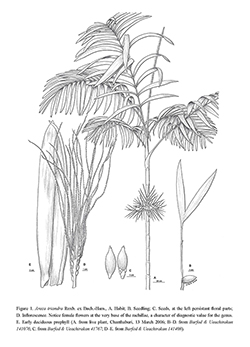e-Flora of Thailand
Volume 11 > Part 3 > Year 2013 > Page 331 > Arecaceae > Areca
3. Areca triandra Roxb. ex Buch.-Ham.wfo-0000263352
Mem. Wern. Nat. Hist. Soc. 5(2): 310. 1826; J.Dransf. et al., Thai Forest Bull., Bot. 32: 34. 2004; A.J.Hend., Palms of Southern Asia: 30. 2009, pro parte. Fig. 1.
Accepted Name : This is currently accepted.
Synonyms & Citations :
Description : Clustering palm, with individual stems up to 6 m tall and 7 cm diam. Leaves 5–8 in crown; leaf sheath forming a yellowish-green up to 60 cm long crownshaft; petiole 30–50 cm long, green glabrous; rachis 1–2 m long, with 13–40 pinnae per side, longest pinnae in the middle, up to 80 cm long. Inflorescence branched to three orders, peduncle 2–3 cm long, rachis 10–40 cm long, flowering branches yellowish-green, rachillae 15–30 cm long, male flowers mostly paired, with 3 stamens. Fruit ellipsoid to ovoid, 2–3 by 1–1.5 cm, red.
Thailand : NORTHERN: Lampang, Phrae, Phitsanulok; EASTERN: Nakhon Ratchasima; CENTRAL: Nakhon Nayok; SOUTH-EASTERN: Chanthaburi, Trat; PENINSULAR: Chumphon, Ranong, Surat Thani, Phangnga, Phuket, Trang, Satun, Yala, Narathiwat.
Distribution : Widely distributed across S Asia from India and Bangladesh (type) reaching the Greater Sunda Islands (Borneo and Sumatra) in the East.
Ecology : Evergreen forests and peatswamp forests, from sea level to 800 m alt.
Vernacular : Mak cha waek (หมากชะแวก), mak ling (หมากลิง)(Chanthaburi); mak nang ling (หมากนางลิง)(Trat); mak no (หมากหน่อ), mak iak (หมากเอียก)(Northern); mak hom (หมากหอม)(Bangkok); mak khiao (หมากเขียว)(Narathiwat); krue-do (กรือดอ)(Malay-Narathiwat).
Conservation Status: Not threatened.
Notes: Areca triandra as circumscribed here only includes part of the variation accommodated in Henderson’s (2009) definition of the same species. Although A. triandra is quite variable in the relative proportions of both the leaves and the inflorescence. It is clearly defined by the combination of clustering habit, many-pinnate leaves and long rachillae.

